How to show up for a remote meeting when you don’t want to

Introduction
As a UX designer, I am at the crossroads of working between stakeholders, users of the digital tools, and the engineers and teams that help build them. Oftentimes we are in meeting rooms together (in-person or remote) talking through ideas, sharing challenges, iterating on a concept, tweaking a layout, prioritizing a feature. These meetings have become the most essential ingredient of my work as a UX designer, and maybe yours too, if you’re working with designers or are creating a digital product.
But meetings can be hard. Like so many other companies, Pixo is two years into all-remote meetings. So of course we’re expert participants by now, right? We’re certainly better than we were in March 2020. But we can all still be just a muted square on a screen sometimes — not engaging as we fully could.
I often hear from others that it’s been hard to show up to these remote meetings. Feelings of disconnection, distractions from their surroundings, or the dreaded “Zoom fatigue” after back-to-back meetings.
That’s real. I’ve felt it and still feel it. And I’ve had to evolve my practice as a UX designer, acknowledging my own limits and making the most out of meetings that I knew were vital to the success of our work.
So how do we show up for a meeting when we don’t want to?
Embrace the opportunity to slow down. Meetings can naturally make us feel uncomfortable because they force us to slow down. To sit still and be “in the moment.” They require you to keep your attention on one thing, which is a practice many of us have trouble doing.
When I slow down in meetings with my colleagues or a client, focusing less on the agenda or “script” at hand and more on the conversation— the reactions on others’ faces, that glimpse of confusion— I witness deeper conversation unfold. Sparks of new ideas or observations. Someone might share an example of something they saw, or we can explore a different approach that wasn’t on the table. It’s moments like this when we get somewhere special. I feel everyone leans in more, their ears perk up. Their attention is in the moment.
But you won’t get to this magical space without everyone’s full attention. If you’re a meeting participant it all comes down to how you show up.
When we meet in-person, it is considered rude to look at your phone, doodle in a notebook, or type away on your laptop. That social pressure means you are more often looking at the person talking, fully engaging and being present. But in remote life, our environment is equipped with so many things that call our attention away from the present moment.
At your next remote meeting, intentionally try one thing to be in the moment. Here are some ideas:
- Turn your video on if you’re used to keeping it off. If you don’t like seeing yourself, try Hide Self View in Zoom.
- Unmute yourself for the whole meeting, not just when you have something to say. You may find it’s easier to get into the flow of the conversation and speak up more often than you would otherwise.
- Silence notifications, put your phone in a drawer, or turn off your second monitor to eliminate that temptation to sneak a peek at another screen.
- Do anything else you can think of to help yourself stay present.
When you give in to distractions and resist engaging in that remote call, you’re adding to the reason why that meeting feels so painful, and as a consequence, taking away from the success of your and your team’s work.
So my advice is to use your next meeting as an experiment (honestly at this point what do you have to lose!). Fight those distractions and engage. Listen. Be there. And see what kind of magic happens.
Want more tips for better meetings?
I’ll be sharing UX strategies for engaging meetings at the University of Illinois Web Conference on Thursday, April 7.